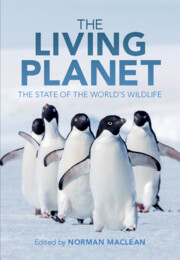Book contents
- The Living Planet
- The Living Planet
- Copyright page
- Contents
- Contributors
- Preface
- Acknowledgements
- One Introduction and the Evolution of Life on Earth
- Two Flowering Plants
- Three Bryophytes and Pteridophytes: Spore-Bearing Land Plants
- Four Terrestrial Mammals
- Five Marine Mammals: Exploited for Millennia, But Still Holding On
- Six How Birds Reveal the Scale of the Biodiversity Crisis
- Seven Reptiles
- Eight Amphibians
- Nine Freshwater Fishes: Threatened Species and Threatened Waters on a Global Scale
- Ten The Amazing Yet Threatened World of Marine Fishes
- Eleven Insects
- Twelve Marine Invertebrates
- Thirteen Non-Insect Terrestrial Arthropods
- Fourteen Terrestrial Invertebrates Other Than Arthropods and Molluscs
- Fifteen Non-Marine Molluscs
- Sixteen An Account of the Diversity and Conservation of Fungi and Their Close Relatives
- Seventeen Simple Life Forms
- Eighteen Assessing Species Conservation Status: The IUCN Red List and Green Status of Species
- Nineteen Problems with the World’s Ecosystems: The Future and Attempts to Mitigate Decline
- Twenty Conservation Methods and Successes
- Twenty One What Does the Future Hold for Our Planet and its Wildlife?
- Species Index
- Subject Index
- References
Fifteen - Non-Marine Molluscs
Published online by Cambridge University Press: 13 April 2023
- The Living Planet
- The Living Planet
- Copyright page
- Contents
- Contributors
- Preface
- Acknowledgements
- One Introduction and the Evolution of Life on Earth
- Two Flowering Plants
- Three Bryophytes and Pteridophytes: Spore-Bearing Land Plants
- Four Terrestrial Mammals
- Five Marine Mammals: Exploited for Millennia, But Still Holding On
- Six How Birds Reveal the Scale of the Biodiversity Crisis
- Seven Reptiles
- Eight Amphibians
- Nine Freshwater Fishes: Threatened Species and Threatened Waters on a Global Scale
- Ten The Amazing Yet Threatened World of Marine Fishes
- Eleven Insects
- Twelve Marine Invertebrates
- Thirteen Non-Insect Terrestrial Arthropods
- Fourteen Terrestrial Invertebrates Other Than Arthropods and Molluscs
- Fifteen Non-Marine Molluscs
- Sixteen An Account of the Diversity and Conservation of Fungi and Their Close Relatives
- Seventeen Simple Life Forms
- Eighteen Assessing Species Conservation Status: The IUCN Red List and Green Status of Species
- Nineteen Problems with the World’s Ecosystems: The Future and Attempts to Mitigate Decline
- Twenty Conservation Methods and Successes
- Twenty One What Does the Future Hold for Our Planet and its Wildlife?
- Species Index
- Subject Index
- References
Summary
Non-marine molluscs stand out as the major animal group under the most severe threat. Among the 8664 mollusc species evaluated for the IUCN Red List (version 2019-1), 300 are considered Extinct out of a total 872 listed Extinct species. However, only ~10% of molluscs have been evaluated and other assessments of the number of extinct species are much higher, 3000 to over 5000, almost exclusively non-marine species. As for most other groups, threats faced by non-marine molluscs are habitat loss, probably the most important, but also impacts of introduced species, exploitation, generally of less concern, and climate change, likely to have serious effects into the future. Oceanic island species, often narrowly endemic, are especially threatened and constitute a high proportion of recorded extinctions. Anthropogenic activities have caused non-marine mollusc extinctions since prehistory, but threats have increased greatly over the last few centuries and will probably continue to increase. Most mollusc species for which a population trend has been evaluated by IUCN are stable or declining; those few that are increasing are primarily introduced and invasive. Most threatened are oceanic island snails, North American and other freshwater bivalves, and the diverse and highly endemic micro-snails of Southeast Asian limestone outcrops.
- Type
- Chapter
- Information
- The Living PlanetThe State of the World's Wildlife, pp. 288 - 310Publisher: Cambridge University PressPrint publication year: 2023
References
- 1
- Cited by



